– AI-applied products and services are expanding and demand for artificial intelligence semiconductors increases
– Global ICT companies also joined the competition to develop artificial intelligence semiconductors on their own, diversifying the value chain
– Venture capital inflows in artificial intelligence semiconductor sector, and start-ups are also active
Artificial intelligence semiconductors and market trends
Artificial intelligence semiconductor is a type of system semiconductor and plays a key role in artificial intelligence as a “semiconductor that executes large-scale operations that require realization of artificial intelligence services such as learning and reasoning with high performance and high power efficiency”. As the wave of digital transformation is getting stronger around the world and industries based on artificial intelligence such as big data analysis, IoT, self-driving cars, and digital health are expanding, the need for artificial intelligence-only semiconductors optimized for artificial neural network algorithms for learning and reasoning As this trend is increasing, technology leading countries including the United States are paying attention to artificial intelligence semiconductors as a core engine of new industries in the future.
<Comparison between conventional semiconductors and artificial intelligence semiconductors>

Artificial intelligence semiconductors are classified in various ways according to architectural structures, service platforms, and technology implementation methods, and generally include GPUs, FPGAs, and ASICs to recent Neuromorphic Chips.
<Classification of artificial intelligence semiconductors>
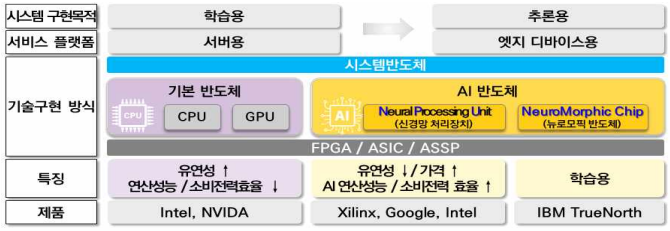
GPU (Graphical Processing Unit) is a parallel processing-based semiconductor designed for graphic image processing that requires a lot of simultaneous computation. FPGAs (Field-Programmable Gate Arrays) are semiconductors that can be optimized and changed according to the purpose through circuit reconfiguration programming, and are characterized by high flexibility depending on the purpose of use. It is characterized by the fastest speed and high energy efficiency among semiconductors. On the other hand, neuromorphic semiconductor is the most advanced form of semiconductor technology that mimics the human brain (neuron-synaptic structure) rather than the existing semiconductor structure and fuses computational processing, storage, and communication functions. do.
According to Gartner, a global market research firm, there are currently more than 50 companies developing artificial intelligence semiconductors worldwide, and as new industries using artificial intelligence expand further in the future, artificial intelligence semiconductor sales will increase from $2020 billion in 230 to $2025 billion in 700. expected to grow beyond that.
<Artificial intelligence semiconductor sales forecast>
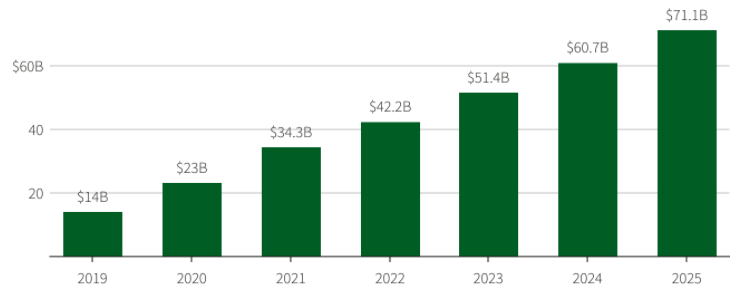
Artificial intelligence semiconductor market trend and major companies in the US
Artificial intelligence semiconductors are expanding the market area by creating a new market in which the existing system semiconductor ecosystem (semiconductor design and manufacturing) and artificial intelligence ecosystem (artificial intelligence products and services are provided) is created, and the market for data centers and edge devices It is segmented and competitive.
First, for data centers, Nvidia and Intel lead the market based on CPU and GPU. In particular, 4% of artificial intelligence accelerators used in the four major cloud services represented by AWS (Amazon Web Services), Microsoft, IBM, and Google are It is owned by Nvidia. For edge devices, the typical applications are smartphones and autonomous vehicles, with Google, Qualcomm, and Tesla leading the market.
Nvidia and AMD have strengths in the GPU field, Intel and AMD in FPGA, Google in ASIC, and IBM and Intel in Neuromorphic.
<Artificial intelligence semiconductor products recently launched or planned to be released by major US companies>
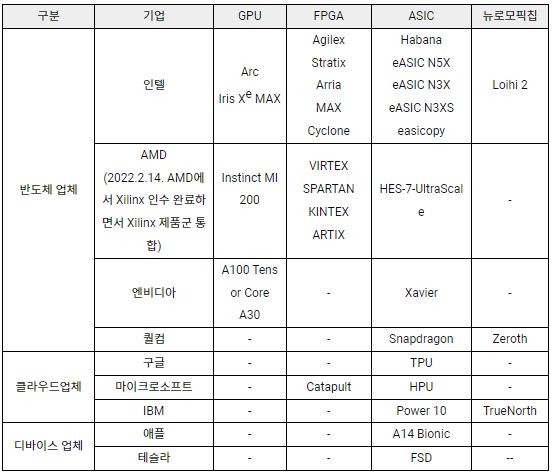
GPU was developed to process complex graphics such as games, but thanks to its parallel processing structure that can process multiple instructions simultaneously, it shows the vast data processing power required for machine learning and deep learning, and for the first time, the possibility of artificial intelligence semiconductors. opened The major companies are Nvidia and AMD of the United States. Nvidia has developed GPUs optimized for data centers and has been active as a leading company in artificial intelligence semiconductors to date. In addition, NVIDIA is promoting cooperative R&D through technological alliances with companies in each industry that apply AI semiconductors based on its semiconductor technology competitiveness, specifically Amazon, Google, Microsoft, HP, IBM, Baidu, Alibaba, Tencent, etc. After developing Xavier, an artificial intelligence semiconductor for driving cars, we are strengthening cooperation with automobile OEMs for future car development. AMD is expanding its presence in the cloud, edge and intelligent computing markets by completing the $2022 billion acquisition of Xilinx on February 2, 14, securing a portfolio of supercomputing, graphics and adaptive SoCs.
FPGA is an artificial intelligence semiconductor suitable for implementing an artificial intelligence inference service that quickly calculates the output value of a learning model optimized through machine learning for a specific purpose. The main companies are Intel and AMD of the United States. By acquiring Xilinx, which was leading the FPGA market, AMD has secured a wide range of FPGA products including VIRTEX. Intel is providing standalone FPGAs and integrated FPGAs (FPGA-CPUs) to secure AI-specialized technology.
ASIC is a custom-made semiconductor manufactured for a specific purpose instead of using a general-purpose processor to implement an artificial intelligence system suitable for the characteristics of the application. Accordingly, in addition to existing semiconductor companies such as Intel, global ICT companies such as Google, Tesla, and Apple are developing their own ASIC chips with embedded artificial intelligence algorithms. Google has been developing ASIC-type artificial intelligence semiconductors directly after launching the first generation of TPU (Tensor Processing Unit) for data analysis and deep learning as the demand for services using artificial intelligence technology grows. Recently, Google Cloud also announced that it will partner with Intel to develop ASIC-based IPUs and sell data center chips to third parties. Tesla is also designing and developing an artificial intelligence semiconductor FSD (Full Self Driving) computer that is installed in fully autonomous vehicles on its own, and installing the semiconductor in its vehicles and releasing it.
Venture capital inflows and startups are also active
As the demand for processors capable of handling AI workloads continues to grow, particularly in data centers and autonomous vehicle sectors, venture capital funds are also flowing into the AI semiconductor sector at a frightening rate. According to data analyzed by Pitchbook, artificial intelligence and machine learning semiconductor manufacturers received $2021 billion in funding in the first quarter of 1 alone, which is more than the sum of all inflows to the sector in the first quarter of 17. .
<Scale of venture capital inflow into artificial intelligence and machine learning semiconductor field>
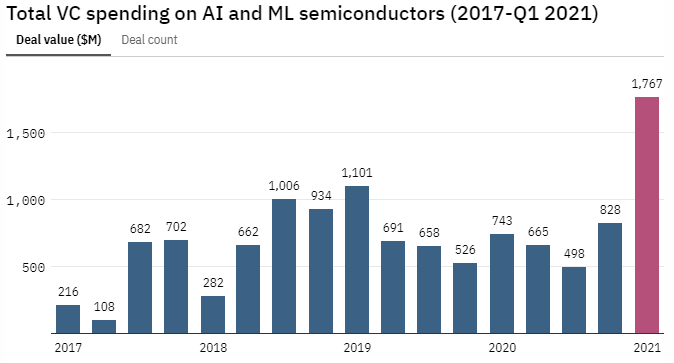
(Unit: US$ million)
Meanwhile, in the US, start-ups developing next-generation artificial intelligence semiconductors based on excellent semiconductor design manpower infrastructure are also appearing one after another. Key startups include Silicon Valley-based Cerebras, Mythic, Groq, Esperanto Technologies, SambaNova Systems, EdgeQ, and San Diego-based Kneron. A mid-sized VC company based in Silicon Valley said in an interview with the KOTRA Silicon Valley Trade Center, “New companies developing artificial intelligence semiconductors, including Silicon Valley, continue to emerge, and venture capital into the AI semiconductor field for mobile and other embedded computing applications. Funds are pouring in,” he said.
<Major artificial intelligence semiconductor development start-ups in the United States>
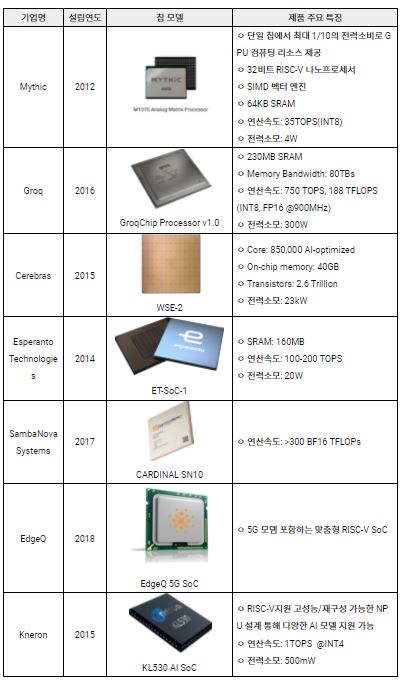
In this regard, Reuters said that Silicon Valley's venture capitalists, who have been focusing on software and IT companies, are paying attention to emerging artificial intelligence semiconductor companies. One fact was reported, and the CEOs of the two companies reported an interview that said that there were more funding rounds than expected as investors' interest in the artificial intelligence semiconductor sector increased.
implication
As mentioned above, as major industries using artificial intelligence are rapidly growing in the United States, the demand for artificial intelligence semiconductors is expected to continue to increase in the future, but at the same time, non-semiconductor companies such as automobile and software companies As the trend of developing artificial intelligence semiconductors directly for the purpose of improving service performance and increasing server operation efficiency or new startups rapidly entering the market based on abundant infrastructure continues, market competition is diversified and the existing value chain the situation is changing.
Experts see this as an opportunity to expand the Korean semiconductor industry centered on memory semiconductors to system semiconductors, as the AI semiconductor sector is still in its infancy. In order for Korea to secure competitiveness in the U.S. market in the future, it is actively utilizing the global value chain, such as securing source technology related to artificial intelligence semiconductors, as well as establishing a cooperative system with design specialists (fabless) and global ICT companies. This is preferable. Also, the importance of securing AI technology competitiveness by developing AI semiconductors (hardware) and AI-applied platforms (software) together is being discussed. It would be better to leave
Source: Deloitte, Gartner, ETRI, Pitchbook, Reuters, Market and Market, IITP, CRN, Crunchbase, KOTRA Silicon Valley Trade Center



